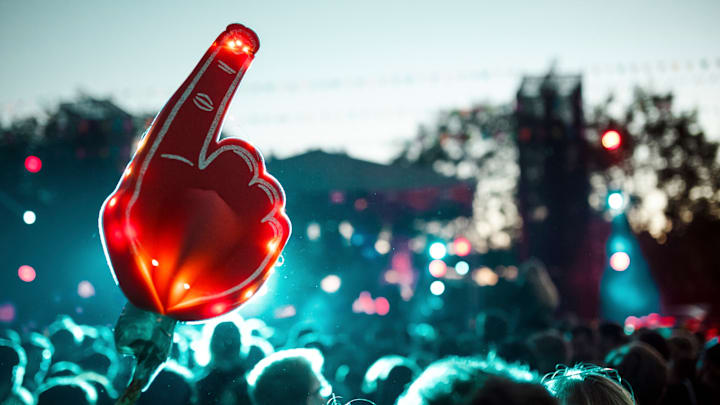There are objects that you can’t associate with anything other than a good time, like beer helmets, Hulk hands, and those inflatable tube men dancing in the air outside used car lots. And, of course, big-ass foam fingers.
There’s something about them, these oversized sponge hands with a pointing index finger, that’s just so happy. The foam appendages frequently appear in team colors, emblazoned with the insistence of being number one, and represent the excitement and occasionally cartoonish overconfidence that being a sports fan is all about. The truth is, most teams aren’t really number one, and half the fans in most stadiums are going home unhappy. But when you’re waving a giant finger around, what's the difference? Victory and happiness are almost always assured.
It certainly feels like foam fingers mean winning. Part of this is probably confirmation bias—when a losing team’s supporters are feeling discouraged, they lower that big foam accessory and usually don’t make the telecast. If you’re weeping with distress at your team’s defeat, you slip the big cartoon hand off in order to place your head in your real ones. But it all begs the question, why?
The Evolution of the Foam Finger
The foam finger began with an Iowa high school student named Steve Chmelar. In 1971, Chmelar built a giant hand from hardware cloth and paper mache with an extended index finger to cheer on Ottumwa High’s basketball team in a state championship game. Ottumwa—also the alma mater of actor Tom Arnold—lost, but the Ottumwa Courier printed a picture of Chmelar and his finger, and a new fad was born.
Six years later, the design got a makeover. Geral Fauss, an industrial arts teacher at Cy-Fair High School just outside Houston, Texas, made 400 oversized pointing hands out of masonite (engineered wood) and sold all of them to raise money for the industrial arts club.
Confident that he was on to a winner, he sold Texas masonite fingers at the 1978 Cotton Bowl Classic (to no avail, as the Longhorns lost to Notre Dame, 38-10). Despite their considerable weight, they all sold out in 20 minutes. Fauss experimented with other materials, most of which seemed too fragile, before settling on the artificial sponge polyurethane.
Fauss founded Spirit Hand Novelties, Inc., which still exists as a sign manufacturer. The company gained massive exposure after making foam fingers for Penn State and Alabama ahead of the 1979 Sugar Bowl (which Alabama won 14-7). The foam fingers became a phenomenon, and by peak times in 1982, Spirit was making up to 5000 hands a day.
Foam fingers are now ubiquitous at sports events worldwide, although the rise of online shopping and overseas manufacturers means they’re made by far more than just one company now. They’ve popped up at entertainment events too: In 2013, after Miley Cyrus cavorted with a foam finger and Robin Thicke at the VMAs, Fox Sports tracked down Chmelar. “She took an honorable icon that is seen in sporting venues everywhere and degraded it,” he said. “Fortunately, the foam finger has been around long enough that it will survive this incident.”
The appeal remains pretty universal: they’re big, simple, and silly and spread all-purpose, event-agnostic positivity. As Fauss once told Sports Illustrated, “Fans like to wave things during games. It’s just another thing to wave.”
Discover More Fascinating Facts About Sports History:
